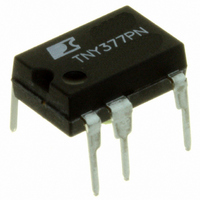TNY377PN Power Integrations, TNY377PN Datasheet - Page 3

TNY377PN
Manufacturer Part Number
TNY377PN
Description
IC OFFLINE SWIT OVP OTP HV 8DIP
Manufacturer
Power Integrations
Series
TinySwitch®-PKr
Type
Off Line Switcherr
Datasheet
1.TNY376PN.pdf
(22 pages)
Specifications of TNY377PN
Output Isolation
Isolated
Frequency Range
132 ~ 280kHz
Voltage - Output
700V
Power (watts)
28W
Operating Temperature
-40°C ~ 150°C
Package / Case
8-DIP (0.300", 7.62mm), 7 Leads
Output Voltage
700 V
Input / Supply Voltage (max)
9 V
Input / Supply Voltage (min)
- 0.3 V
Duty Cycle (max)
65 %
Switching Frequency
264 KHz
Supply Current
570 uA
Operating Temperature Range
- 40 C to + 150 C
Mounting Style
Through Hole
Maximum Operating Temperature
+ 150 C
Minimum Operating Temperature
- 40 C
Output Current
1.4 A
Output Power
28 W
Lead Free Status / RoHS Status
Lead free / RoHS Compliant
Other names
596-1144-5
Available stocks
Company
Part Number
Manufacturer
Quantity
Price
Company:
Part Number:
TNY377PN
Manufacturer:
POWER
Quantity:
15 000
pulled from the pin drops to less than a threshold current. A
modulation of the threshold current reduces group pulsing. The
threshold current is between 75 μA and 115 μA.
The EN/UV pin also senses line undervoltage conditions through
an external resistor connected to the DC line voltage. If there is
no external resistor connected to this pin,
TinySwitch-PK detects its absence and disables the line under-
voltage function.
SOURCE (S) Pin:
This pin is internally connected to the output MOSFET source for
high voltage power return and control circuit common.
TinySwitch-PK Functional Description
TinySwitch-PK combines a high voltage power MOSFET switch
with a power supply controller in one device. Unlike conventional
PWM (pulse width modulator) controllers, it uses a simple ON/
OFF control to regulate the output voltage.
The controller consists of an oscillator, enable circuit (sense and
logic), current limit state machine, 5.85 V regulator, BYPASS/
MULTI-FUNCTION pin undervoltage, overvoltage circuit, and
current limit selection circuitry, over-temperature protection,
current limit circuit, leading edge blanking, and a 700 V power
MOSFET. TinySwitch-PK incorporates additional circuitry for line
undervoltage sense, auto-restart, adaptive switching cycle on-
time extension, and frequency jitter. Figure 2 shows the
functional block diagram with the most important features.
Oscillator
The typical oscillator frequency is internally set to an average of
264 kHz (at the highest current limit level). Two signals are generated
from the oscillator: the maximum duty cycle signal (DC
clock signal that indicates the beginning of each cycle.
The oscillator incorporates circuitry that introduces a small
amount of frequency jitter, typically ±3% of the oscillator
frequency, to minimize EMI emission. The modulation rate of the
600
500
400
300
200
100
Figure 4.
www.powerint.com
0
0
Frequency Jitter.
Time (μs)
280 kHz
248 kHz
V
DRAIN
2.5
MAX
) and the
5
frequency jitter is set to 1 kHz to optimize EMI reduction for both
average and quasi-peak emissions. The frequency jitter should
be measured with the oscilloscope triggered at the falling edge of
the DRAIN waveform. The waveform in Figure 4 illustrates the
frequency jitter with an oscillator frequency of 264 kHz.
Enable Input and Current Limit State Machine
The enable input circuit at the EN/UV pin consists of a low
impedance source follower output set at 1.2 V. The current
through the source follower is limited to 115 μA. When the
current out of this pin exceeds the threshold current, a low logic
level (disable) is generated at the output of the enable circuit
until the current out of this pin is reduced to less than the
threshold current. This enable circuit output is sampled at the
beginning of each cycle on the rising edge of the clock signal.
If high, the power MOSFET is turned on for that cycle (enabled).
If low, the power MOSFET remains off (disabled). Since the
sampling is done only at the beginning of each cycle,
subsequent changes in the EN/UV pin voltage or current during
the remainder of the cycle are ignored. When a cycle is
disabled, the EN/UV pin is sampled at 264 kHz. This faster
sampling enables the power supply to respond faster without
being required to wait for completion of the full period.
The current limit state machine reduces the current limit by
discrete amounts at light loads when TinySwitch-PK is likely to
switch in the audible frequency range. The lower current limit
raises the effective switching frequency above the audio range
and reduces the transformer fl ux density, including the
associated audible noise. The state machine monitors the
sequence of enable events to determine the load condition and
adjusts the current limit level accordingly in discrete amounts.
Under most operating conditions (except when close to no-
load), the low impedance of the source follower keeps the
voltage on the EN/UV pin from going much below 1.2 V in the
disabled state. This improves the response time of the
optocoupler that is usually connected to this pin.
5.85 V Regulator and 6.4 V Shunt Voltage Clamp
The 5.85 V regulator charges the bypass capacitor connected
to the BYPASS pin to 5.85 V by drawing a current from the
voltage on the DRAIN pin whenever the MOSFET is off. The
BYPASS/MULTI-FUNCTION pin is the internal supply voltage
node. When the MOSFET is on, the device operates from the
energy stored in the bypass capacitor. Extremely low power
consumption of the internal circuitry allows the TNY375 and
TNY376 to operate continuously from current taken from the
DRAIN pin. A bypass capacitor value of 0.1 μF is suffi cient for
both high frequency decoupling and energy storage.
In addition, there is a 6.4 V shunt regulator clamping the
BYPASS/MULTI-FUNCTION pin at 6.4 V when current is
provided to the BYPASS/MULTI-FUNCTION pin through an
external resistor. This facilitates powering of TinySwitch-PK
externally through a bias winding as required for TNY377-380.
Powering the TinySwitch-PK externally in this way also
decreases the no-load consumption to below 60 mW.
TNY375-380
Rev. C 07/09
3












